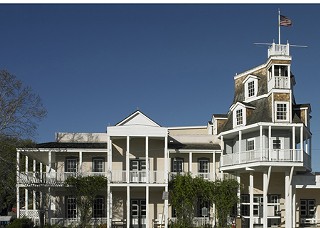Day Trips
The National Museum of the Pacific War in Fredericksburg is a must-visit for World War II buffs
By Gerald E. McLeod, Fri., Jan. 25, 2008
The National Museum of the Pacific War in Fredericksburg hosts an in-depth study of the Pacific Theater of Operations of World War II. Through photographs, artifacts, and stories, the exhibits cover the era from the causes of the war to the ultimate end at Nagasaki, Japan.
"More than anything else," says Dolores Young, public relations officer for the museum, "it is the story about the people who fought the war." From the trenches to the home front, few details of the war are overlooked.
Originally called the Admiral Nimitz Museum, the history display honored all of the service personnel in the Pacific and was housed in the old Nimitz Hotel. The commander of the U.S. fleet in the Pacific, Chester W. Nimitz, spent much of his early childhood with his grandfather at the hotel.
Charles H. Nimitz Sr. went to sea with the German merchant seaman as a 14-year-old. He landed in Charleston, S.C., in 1844, and was among the first German settlers to arrive in Fredericksburg in 1846. By 1855, grandpa Nimitz had opened a six-room hotel on the road from the Gulf Coast to California.
The business prospered, as Nimitz offered travelers the only hot baths between San Antonio and San Diego. The hotel grew to include a basement brewery, a concert/dance hall, and one of the best meals west of the Mississippi. By the mid-1870s, the hotel had a three-story front that resembled a steamboat.
The future fleet commander was born on Feb. 24, 1885, a few blocks from the Nimitz Hotel. After his father died, Chester and his mother moved into the hotel, and his grandfather became a father figure in his life. Although his mother remarried and moved to Kerrville, the old man remained a strong influence on his grandson. Nimitz moved to the Naval Academy in 1901 and never lived in the Texas Hill Country again.
By 1963, the hotel was sold by the family and was closed. The steamboat front had been removed in the 1920s, and the building had fallen into disrepair. A group of concerned citizens saved the building from the wrecking ball in 1966. Three years later it became a state historic site, and by 1981 it was being administered by the Texas Parks and Wildlife Department.
For many years the museum was a dark maze of exhibits honoring the men and women who fought in the Pacific Theater. The one bright spot was the Japanese Garden donated by the Japanese and built by Japanese gardeners in 1976. The beautifully kept sanctuary remains a monument to the peace shared between the two countries.
When President George H.W. Bush cut the ribbon to the George Bush Gallery in 1999, he opened a new phase in the museum's development. Most of the exhibits were moved out of the cramped quarters in the hotel and the building was remodeled to more closely resemble its original floor plan.
In 2005, the museum became a Texas Historical Commission property administered by the Admiral Nimitz Foundation. ("Day Trips" No. 861 mistakenly said the property was transferred between state agencies in 2007.) The foundation has greatly expanded the museum's fundraising and educational programs.
The Admiral Nimitz Museum is now five museums rolled into one – the Nimitz collection, the George Bush Gallery, the Memorial Courtyard, the Japanese Garden of Peace, and the Pacific Combat Zone (a collection of war machinery). Experiencing the exhibit feels like walking through a history book. Each major battle of the Pacific War is highlighted with details and illustrated with equipment and photographs. Not only does the collection include a miniature Japanese submarine captured at Pearl Harbor and a PT boat, but also soldiers' letters home, women's underwear woven from whatever materials were available, and an American flag made by POWs. It is an inspiring journey back in time when uncommon bravery was a common virtue.
The National Museum of the Pacific War is at 340 E. Main St. in Fredericksburg. Doors open daily (except Thanksgiving and Christmas) at 9am and close at 5pm. Museum admission for adults begins at $7, with discounts for students, veterans, and seniors. Admission to the grounds is free. For information, call 830/997-8600 or go to www.nimitz-museum.org.
864th in a series. Day Trips, Vol. 2, a book of "Day Trips" 101-200, is available for $8.95, plus $3.05 for shipping, handling, and tax. Mail to: Day Trips, PO Box 33284, South Austin, TX 78704.









